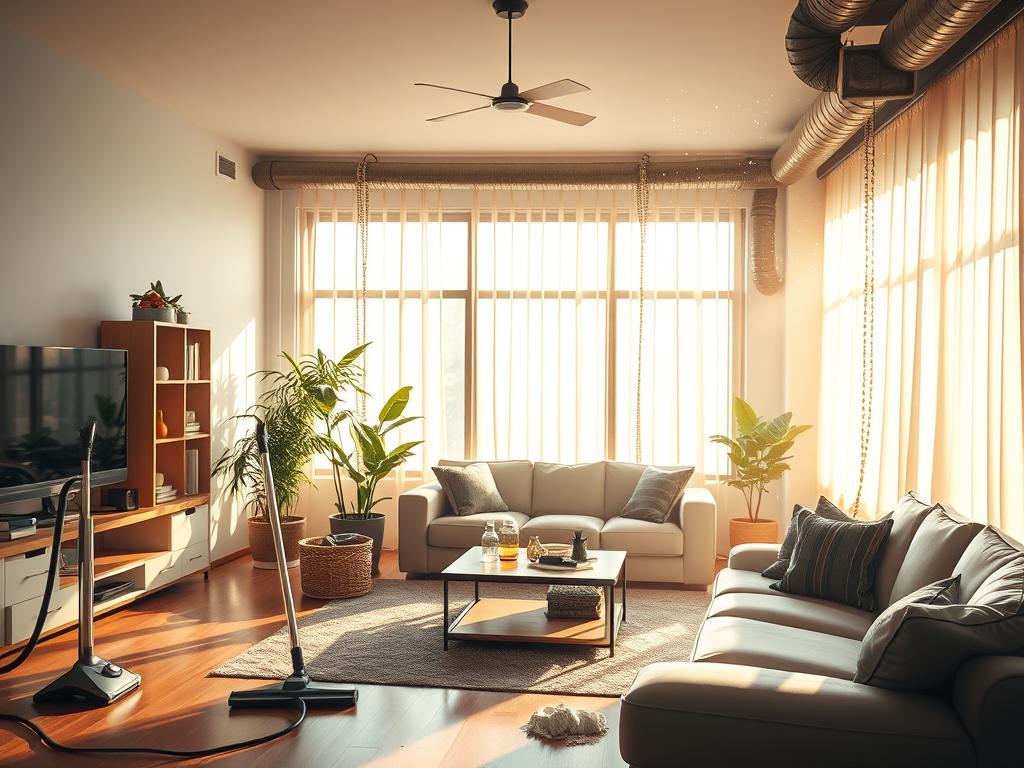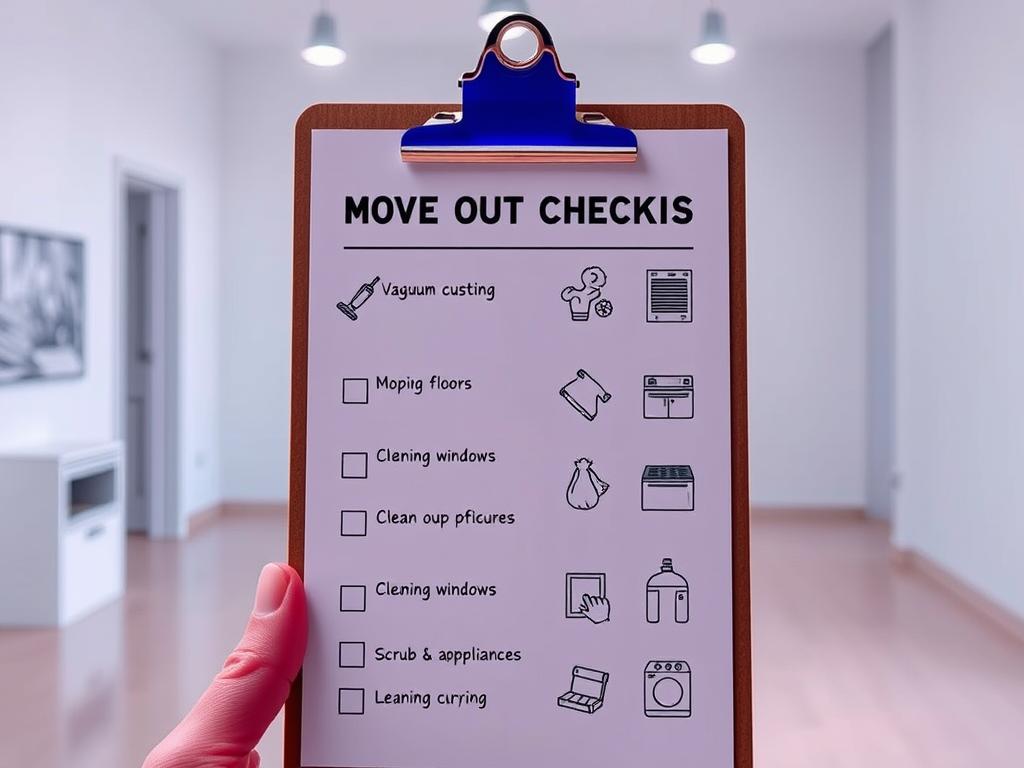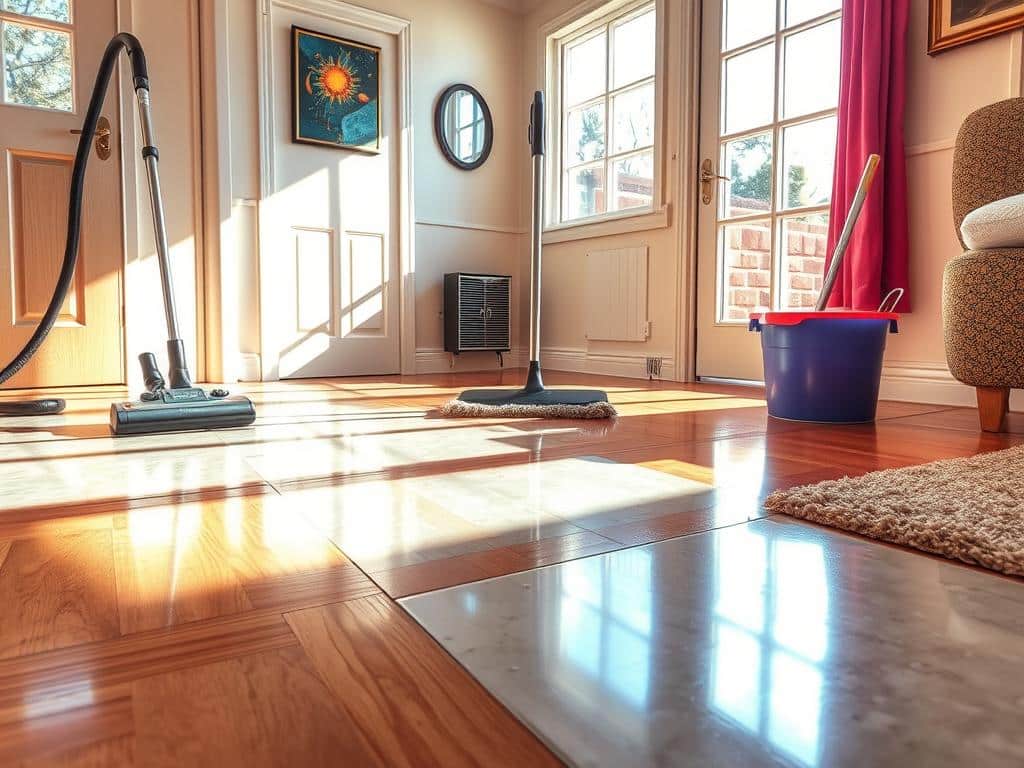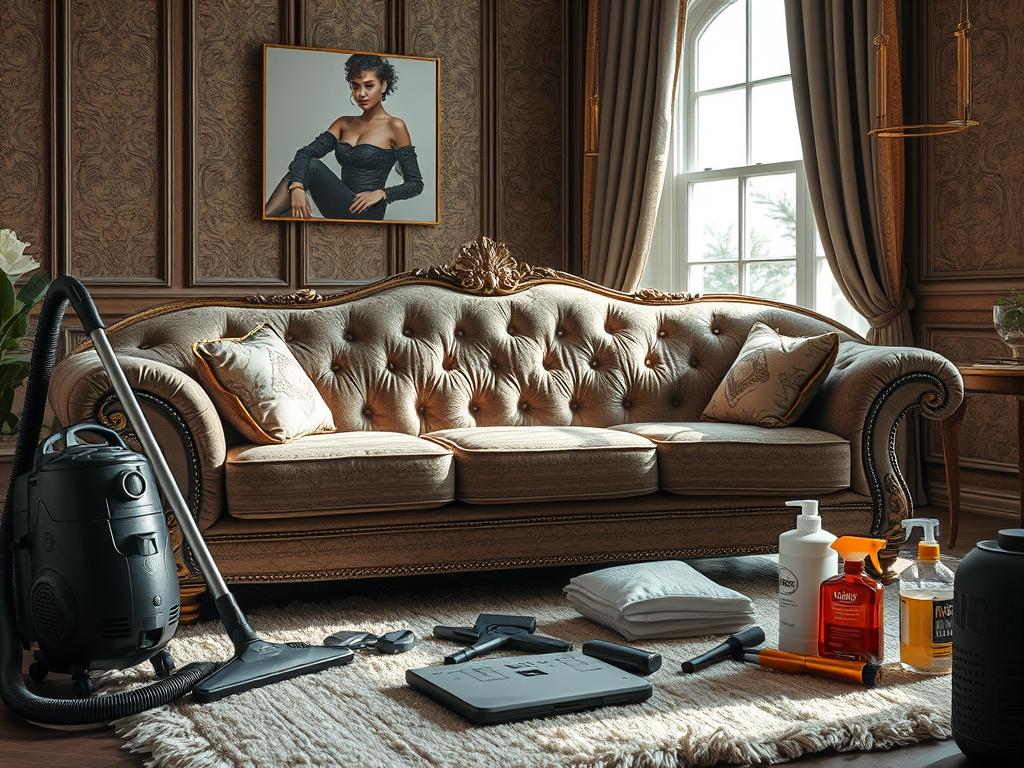
Keeping your home’s furniture clean is key to a healthy living space. Deep cleaning your upholstery makes your furniture last longer. It also keeps your home smelling fresh and free of dust. The steps to clean a sofa well include removing stains, vacuuming properly, and using smart cleaning tricks. We’ll show you how to clean like a pro.
Each piece of upholstered furniture has its own cleaning instructions. These are found on tags under the cushions. They tell you how to clean and care for your furniture correctly. Ignoring these could damage your furniture or not clean it well.
Vacuuming regularly keeps your upholstery in good shape. It gets rid of dust, pet hair, and other dirt, making cleaning easier. When dealing with fabrics like suede, always vacuum in the direction of the fabric. A bit of baking soda can help get rid of bad smells. Just sprinkle it on, wait 15-20 minutes, and vacuum it off.
Dealing with stains quickly helps a lot. Different stains need different cleaners. For example, water-based stains use warm water and mild dish soap. But, you might need baking soda for oil-based stains. Sometimes, a homemade mix of warm water, vinegar, and soap works. But, tough stains might need a pro.
To keep your upholstery clean, taking steps to prevent dirt helps. Using air filters and changing them out often works well. Also, keeping pets off the furniture helps. For a thorough clean, tools like the Karcher DS6 Vacuum Cleaner or the Karcher Spray Extraction Cleaner can be great.
In short, clean upholstery by knowing the cleaning codes, vacuuming often, and acting fast on stains. These actions help keep your furniture looking great. They also make your home more welcoming and comfortable.
Understanding Upholstery Codes
Upholstery codes on furniture care labels are key to proper cleaning. These codes help you know how to keep your furniture looking its best. By using the right cleaning solutions and methods, you avoid damaging your pieces.
Deciphering the Tag Information
Look for tags or labels on your furniture for cleaning instructions. These tags use a cleaning code system with letters like W, S, W/S, and X. Knowing what these symbols mean is crucial.
- W: Indicates water-based cleaning solutions can be used. Common for fabrics that are more resilient to water.
- S: Signifies solvents should be used. Suitable for materials that might get damaged by water-based cleaners.
- W/S: Both water-based and solvent-based cleaners are safe depending on the stain’s nature.
- X: Use only vacuuming or dry brushing. No liquids should be applied, which might necessitate professional cleaning services.
Experts like Jennifer Parnell from Humble Suds say to always check labels before cleaning. Following these precautions helps you maintain your furniture without damage. Kathy Cohoon from Two Maids agrees, emphasizing the value of these guidelines.
Common Upholstery Cleaning Codes
The cleaning codes on your furniture’s tags show safe cleaning methods. Understanding these codes is essential before you start. Let’s examine what each code represents:
- W (Wet): Safe for water-based cleaning solutions.
- S (Solvent): Requires solvent-based cleaners, avoiding water-based products.
- W/S (Wet and Solvent): Both water and solvent-based cleaners can be used, providing more flexibility.
- X (Vacuum only): No liquids or solvents should be used; only vacuuming or dry cleaning is recommended.
Knowing these codes, you can maintain your upholstery well. This keeps your furniture looking great and lasting longer. Always check the labels before cleaning for the best outcome.
Essential Tools and Supplies for Upholstery Cleaning
When it comes to upholstery care, the right tools and supplies are crucial. They help keep your furniture looking good and lasting longer. Whether you’re cleaning sofas, chairs, or stools, the right equipment makes the job easier and more effective.
Vacuum Cleaners and Attachments
Vacuuming is a key first step in upholstery care and should be done often. A vacuum with the right attachments can pull up pet hair and dirt from fabric. Materials like polyester and microfiber, which are common in furniture, need regular vacuuming. Using an upholstery brush attachment helps avoid damage to sensitive fibers.
Cleaning Solutions and Solvents
Choosing the right cleaning solutions is important for removing stains and odors. Mild detergent, vinegar, and distilled water are effective, according to Humble Suds. Baking soda is great for neutralizing odors. It works well with fabric fresheners. Euro Maids recommend steam cleaners and specific solvents for different fabric codes. Always test a cleaning solution on a small area first to avoid damage.
Brushes and Cloths
Brushes and cloths are key for keeping upholstery in good shape. Dry brushes help fluff up fabric, making furniture look fresh. Microfiber cloths are great for cleaning without causing scratches. They save money and are gentle on surfaces. A fabric protector can also shield against spills.
For tips on cleaning Boucle fabric, check out this guide. Following these suggestions will help your upholstery stay in great condition, adding comfort and style to your home.
Pre-Cleaning Steps to Ensure Success
Getting your upholstery clean starts with good prep work. Make sure to have a checklist for all important tasks. This means vacuuming away dust, keeping pets away, and tackling any spots that need extra attention. Let’s dive into why these steps are so key to a smooth pre-cleaning phase:
Removing Dust and Debris
First up, getting rid of dust and debris is key. Use a vacuum on the upholstery to get rid of dirt, pet fur, and allergens. A brush can help shake loose anything stuck in the fabric. Clearing away clutter not only makes cleaning more effective but also quicker. This step is the foundation for a hassle-free cleaning session.
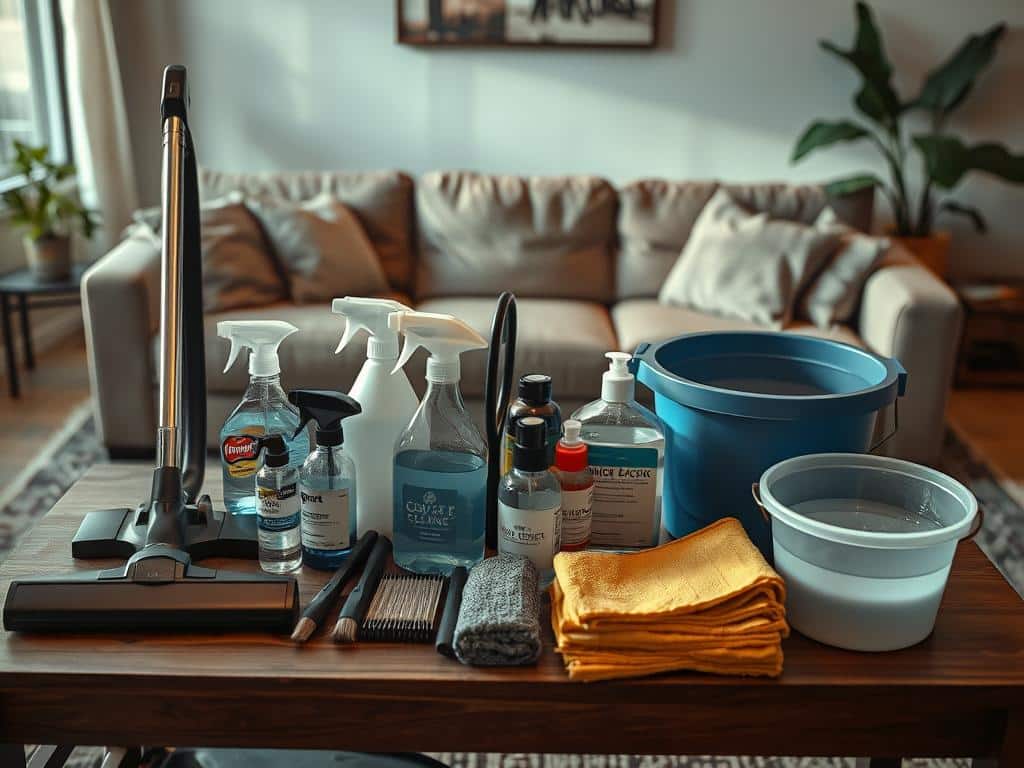
Spot Testing Cleaning Solutions
Testing cleaning solutions on a hidden spot is critical. This ensures they won’t harm or change the fabric’s color. Doing this avoids problems and confirms the solution works well. A Plus Carpet Cleaning pros stress doing this test right to protect your furniture.
Protecting Surrounding Areas
It’s vital to safeguard the areas around where you’re cleaning. Use sheets or plastic to cover nearby furniture and floors. This guards against spills and damage while cleaning. Making sure paths to the cleaning spot are clear helps the cleaning team work faster. For tips on protective steps, check out [this guide](https://www.squeakycleaner.homes/expert-guide-how-to-clean-a-watch/).
By following these pre-cleaning steps, you’re prepping for a successful deep clean of your upholstery. This ensures great results and helps your furniture last longer.
Step-by-Step Guide to Deep Cleaning Upholstery
Making your furniture look brand new is achievable with a good deep clean. Follow this guide to clean every part of your upholstery. This will get rid of any smells or stains.
Vacuuming Thoroughly
The first step is to vacuum your upholstery well. Use a strong vacuum cleaner and the right tools to get into all the small spaces. This gets rid of dirt, dust, and crumbs. It stops them from getting stuck in the fabric.
Applying Baking Soda for Odor Removal
To remove smells, sprinkle lots of baking soda on the furniture. Let it sit for at least 15 minutes. It soaks up bad odors. Then, vacuum up the baking soda. This step removes smells safely, without harsh chemicals.
Using Water or Solvent-Based Solutions
Check the care instructions to know if you should use water or a solvent for cleaning. Use water-based cleaners for most types of fabric. But, choose solvents for materials like velvet or water-sensitive fabrics.
- Crypton fabric: Known for stain resistance and moisture barriers.
- Outdura fabrics: Durable and easy to clean, often recommended to use diluted bleach for stubborn stains.
- Sunbrella fabrics: Treated with a water- and stain-repellent finish.
Blotting and Drying Techniques
After you’ve cleaned it, use a microfiber cloth to dab the fabric gently. Don’t rub it – that can harm the fabric. Let the upholstery air dry well. It’s best to wait 4-6 hours before using the furniture again. Using fans can dry it faster and help avoid mold or mildew.
Deep Cleaning Upholstery: Tips for Different Fabric Types
Deep cleaning your upholstery needs a special cleaning plan for each fabric. This means understanding the right way to care for each type. It will keep your furniture looking good and lasting longer.
First, always look at the upholstery care codes on your furniture tags. These codes tell you how to clean your furniture safely:
- W – Water-based Cleaners: Use water-based cleaners for “W” code fabrics. You can shampoo these by using a soft soap mix and scrubbing lightly.
- S – Solvent-based Cleaners: “S” means use dry cleaning agents only. Water can harm these fabrics.
- W/S – Water or Solvent-based Cleaners: “W/S” coded fabrics work with both cleaners. This makes cleaning various stains easier.
- X – Vacuum Only: Only vacuum fabrics with an “X”. They need professional cleaning for more serious issues.
Clean regularly to keep stains away and your furniture’s life long. Furniture traps allergens, so clean it well. Treating stains right away prevents damage. Be careful with moisture as it can cause mold.
Each material needs cleaning at different times. Cotton, microfiber, linen, leather, and velvet each have unique needs. Cleaning under cushions weekly keeps them fresh. Sofas and chairs collect dirt faster and need more care.
Sectional sofas hide crumbs and debris in their corners. Renting a cleaning machine can help clean these areas well. After cleaning, dry for 4-6 hours. A fan can speed this up.
How to Handle Stubborn Stains
Removing tough stains from upholstery isn’t easy, but a good strategy helps a lot. Start by figuring out what type of stain it is. Different stains need different cleaning methods. For instance, stains from things like red wine or grape juice are best cleaned with a mix of cold water and soap, plus some white vinegar.
Identifying Stain Types
Knowing what kind of stain you’re tackling is key. Natural stains, like from food and drinks, often come out with vinegar-based cleaners. But for artificial stains, you may need alcohol-based products. To remove grease stains, like from pizza, try using baking soda. Sometimes, you might have to treat the stain more than once.
Using DIY Spot Removers
DIY cleaners can be quite effective for stubborn stains. You can use a mix of dish soap and cold water. If you have pets, enzyme-based cleaners are great for organic stains. Always test the cleaner on a hidden area first to make sure it doesn’t harm your fabric.
Professional Stain Removal Options
If DIY methods don’t work, consider hiring a professional. Experts like Cohoon and Parnell recommend using specialized cleaners for tough stains. They have the right tools and knowledge to clean without damaging your upholstery. Using fabric protectors can help guard against future spills.

